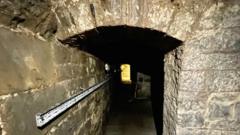Hidden beneath the National Library of Scotland lies a forgotten street called Libberton’s Wynd, a remarkable glimpse into Edinburgh’s historical past. Demolished in the 1830s to make way for George IV Bridge, a section of this ancient street still exists in a hidden corridor staff have named “The Void”.
Discovered in the 1990s by library officials who broke through a small hatch behind filing cabinets, the passageway reveals fascinating remnants of Edinburgh’s old urban landscape. Bill Jackson, a former library director, recalls finding waterlogged artifacts over 100 years old, including rotten furniture, ledgers, shoes, and even a slate urinal.
The corridor runs several hundred feet at a steep gradient and is located between the bridge walls and library building. Library staff have since added lighting and a full-sized door for access. Robbie Mitchell, a reference assistant, notes that visitors can see the original brickwork of the library’s lower levels and the bridge’s stonework, offering a unique historical perspective.
George IV Bridge was constructed to connect Edinburgh’s Royal Mile over the Cowgate, with arched chambers built into multiple floors for storage. The bridge was built directly on the foundations of Libberton’s Wynd, which previously served as a route to the city’s gallows. Notably, infamous body-snatcher and murderer William Burke was executed at these gallows in January 1829.
The street was also home to a famous tavern, initially called The Mermaid and later known as Johnnie Dowie’s Tavern. Described as a house of “much respectability”, it was a popular meeting place for writers, artists, and judiciary members. The tavern’s principal room could accommodate about 14 people, while smaller rooms were so dark they required artificial lighting even during daylight.
Local historian Jamie Corstorphine explains that the wynd likely got its name from Henry Libberton, who owned significant property in the area. The street was incredibly diverse, hosting merchants, barbers, shoemakers, grocers, and various craftsmen like silver turners and glaziers.
Libberton’s Wynd was first mentioned in the late 15th century and was completely demolished by 1835. The most popular drink at the tavern was Edinburgh Ale, brewed by Archibald Younger, which was so strong it was said to “almost glue the lips of the drinker together”.
Today, this hidden corridor serves as a remarkable time capsule, preserving architectural and social fragments of Edinburgh’s past. While not a preserved street like Mary King’s Close, The Void offers historians and visitors an extraordinary glimpse into the city’s rich historical landscape, showcasing the architectural and social evolution of Edinburgh’s Old Town.




